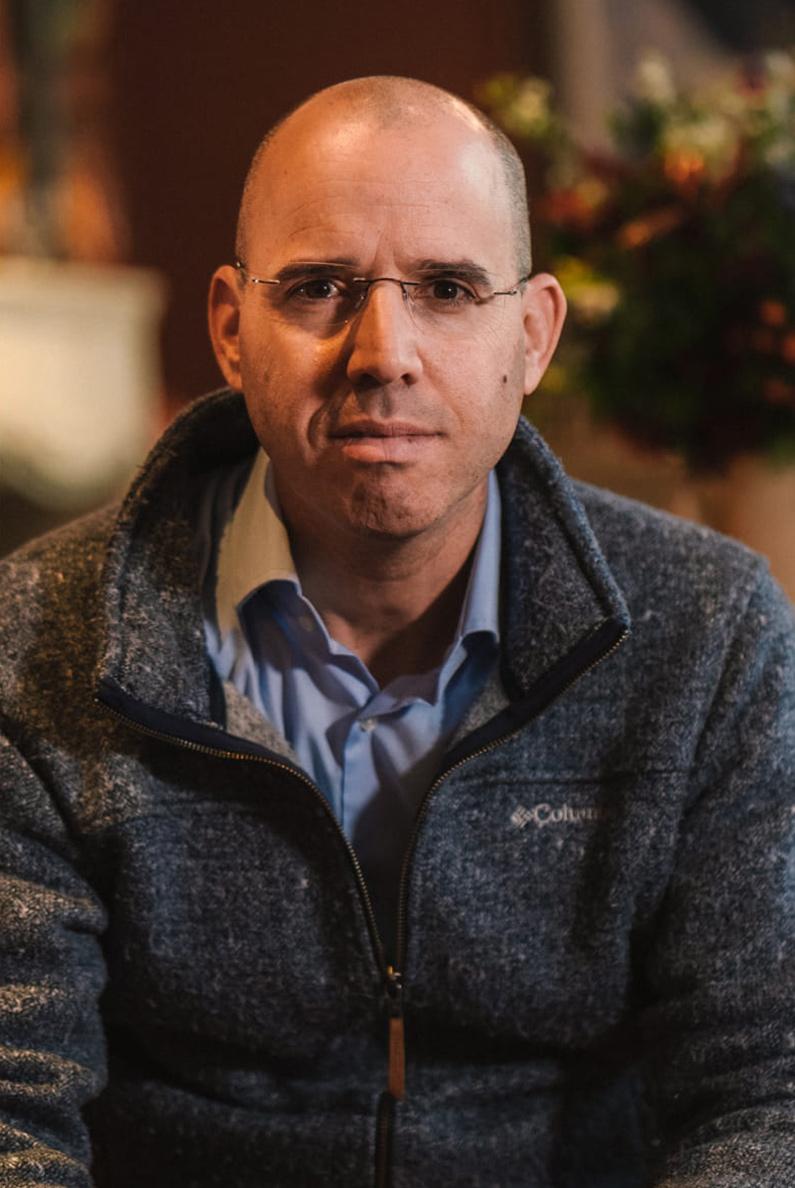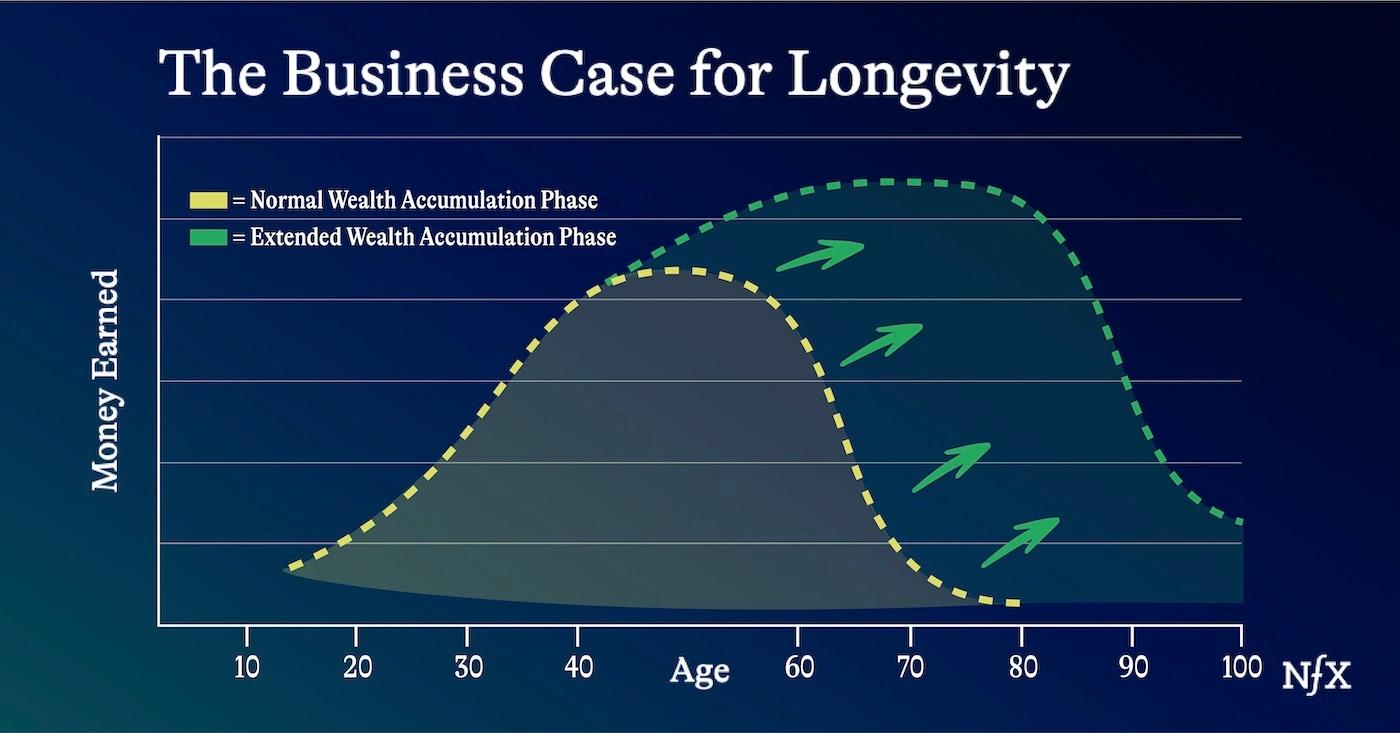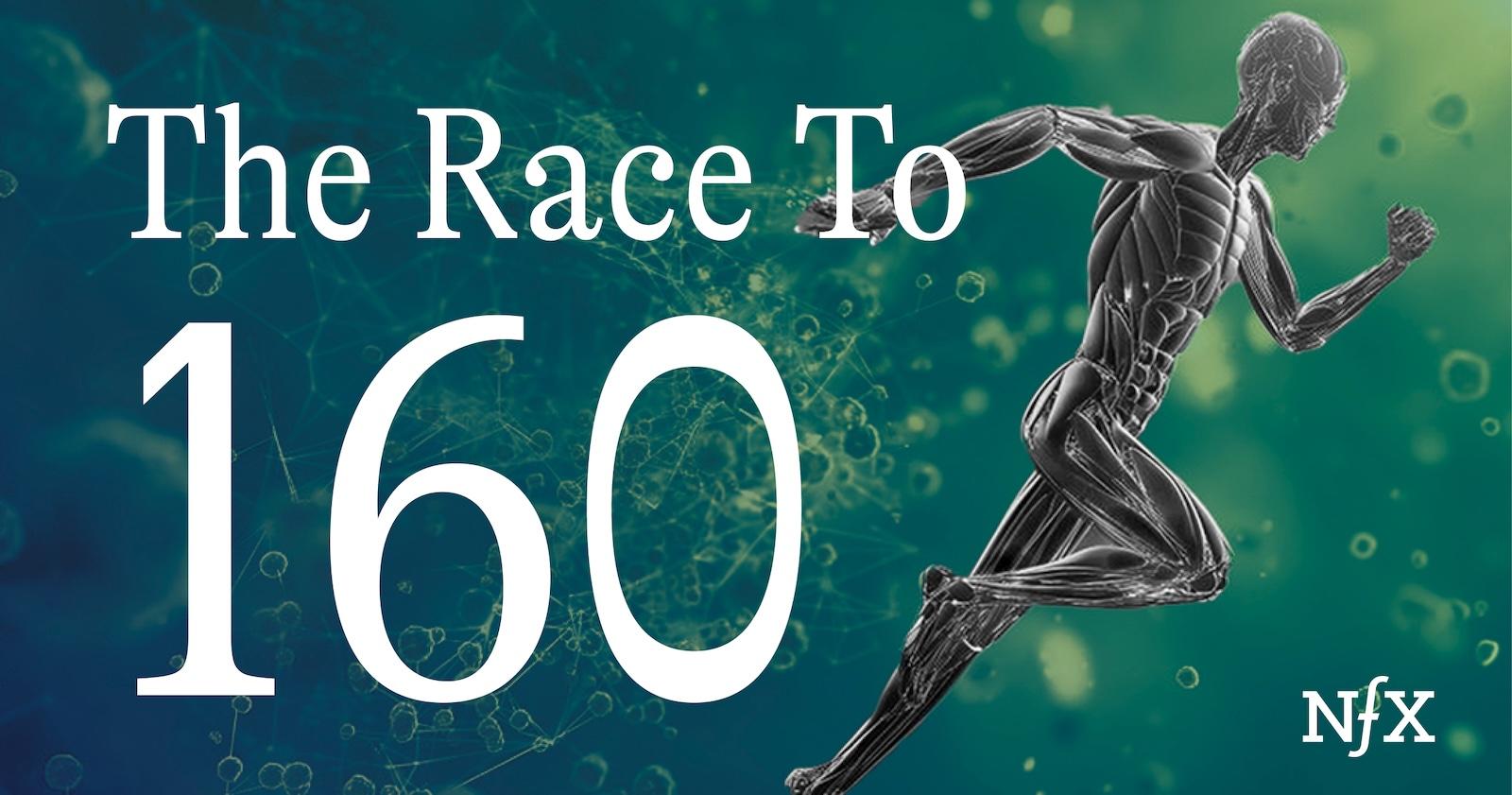

I truly believe that if we are able to live to 160 years old, then we should be able to live (in good health) for as long as we want.
If we can advance longevity science to the point where we reach past 160 years old, there’s a good chance that we’ve solved most of the big problems that kill most people.
If people are living to 160, it probably means we’ve found a reliable way to cure cancer. It probably means we’ve found ways of preventing heart disease or other chronic conditions that kill most people. It probably means we’ve developed ways to replace organs or cells that break down and lose their function over time.
The 160 mark is a signal that we have solved involuntary death.
If we develop ways of curing and managing these diseases, there is, in theory, little limit to how long we can live in good health. Healthy life expectancy will go exponential.
NFX Bio is all in on what we call “the race to 160.” If we can get there, in our lifetime, we think the returns for humanity are unmatched.
You are either going to live in a world where people die of aging and disease, or you aren’t. That’s up to us.
Getting Over The Wall
One of the most famous concepts in longevity is Ray Kurzweil’s and Aubrey De Grey’s “longevity escape velocity.”
Very simply: If you look at almost every year in the last 300 years of human history, life expectancy has grown by a little bit. For every year that passes, maybe you gain a few more days or weeks of life expectancy. And that has played out. We already know that someone born in the 1970s has a few years more years of life expectancy than someone born in 1950.
I think this is right to a point. But it’s going to happen far faster than people think. Rather than gaining a small amount of life expectancy year by year, it’s all going to happen at once.
I think this “wall” exists around about 160 years old. If we can develop technologies that get us to 160 or past it, then there’s a good chance we could extend human lifespan indefinitely.
On one side of that wall, is a world where people die from aging-related diseases. On the other side, is a world where they don’t.
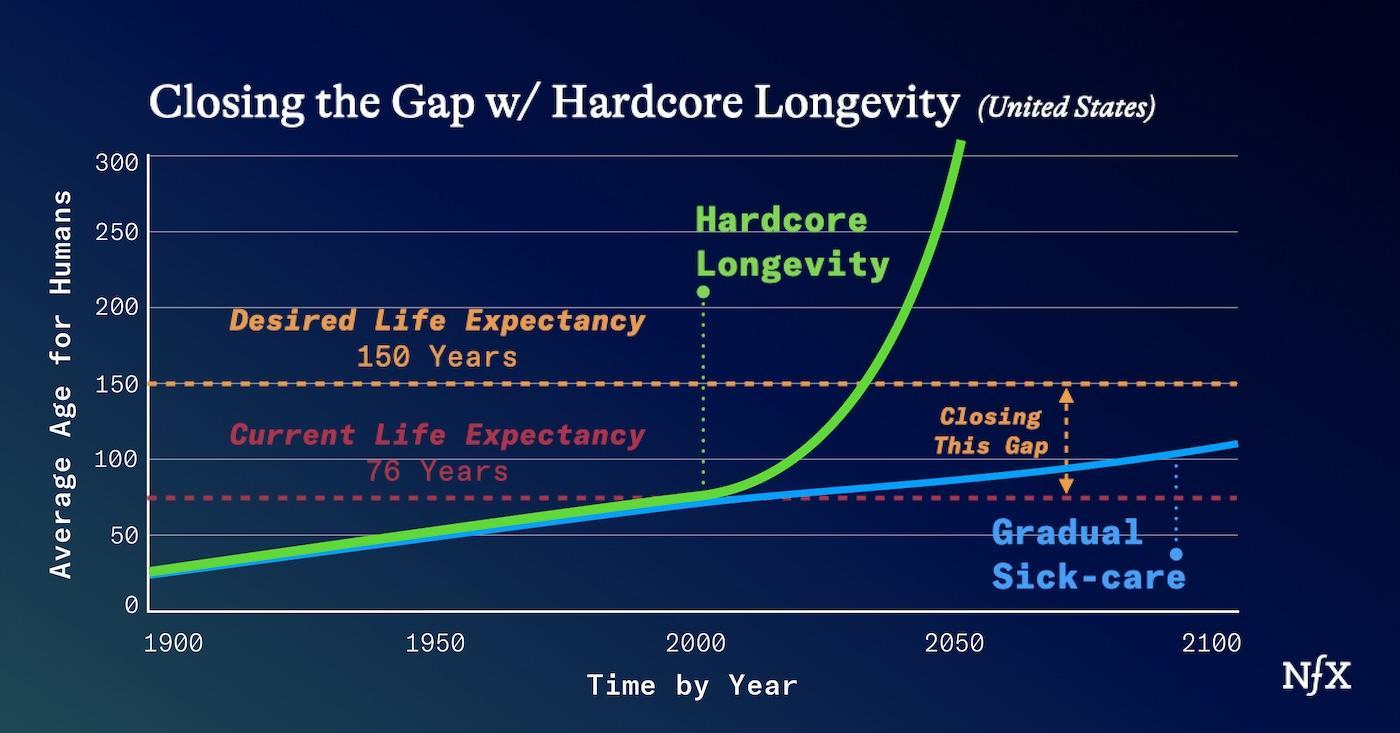

People don’t see it this way right now because we’re inherently bad at expecting exponential change, even though it’s so common in fields like investing, or biology. We never expect to make huge leaps…and then we do.
Why 160?
The oldest people we know have only made it into their 120s. And frankly, most of them have done so through luck, not science. They didn’t get cancer. They didn’t get Alzheimer’s. Maybe they have some magic genes that are helping them live longer. And they were probably born somewhere with good enough healthcare to stop them from dying from the basic stuff, like infections.
But we don’t want luck. We want science. If we can get to the 160 mark (+30 years from the longest a human can live today if they’re extremely lucky), that means we’ve probably solved some of the basic mechanisms of aging that contribute to disease. It probably means we’ve found a way to prevent cancer, or heart disease and dementia, from ever happening.
This really is possible if we stop thinking in the “sick care” mentality we currently have and think about true “health care.” Existing “sick care” – i.e waiting for someone to get sick after years of accumulating damage and then giving them a mediocre drug – maybe gets us a few extra years of life. But to get over the wall, we need medicine that stops us from breaking down in the first place.
If we want to get to 160, we want to keep our chances of dying low, and constant throughout life.
It’s a bit of a hard idea to wrap your head around. So let me break it down.
How to Make Death Optional:
This is a fact of being human: as you grow up, your risk of dying goes up.
Even if you’ve never really thought of this, you kind of know it intuitively. You probably didn’t think about death much when you were 10 years old. But as you get older, it pops into your brain – apparently age 26 is when most people “begin to consider their own death.” It’s that feeling that makes you notice when your parents start to get older. It’s this feeling that there’s a time limit and the clock is ticking. The older we get, the louder that ticking sounds.
It’s not in your head. That clock is real. The concept is described as the Gompertz-Makeham law. The part we’re discussing here is the Gompertz element – the idea that risk of death increases exponentially as we age.
When we’re born, our risk of dying is actually pretty high. Then it takes a dive around the age of 10, and we have a very good chance of not dying, because we’re young and very healthy. The only thing that’s really threatening you is an accident.
That risk stays low(ish) until a certain point (around 65 in the graph below) when it absolutely skyrockets. The risks are now primarily internal – essentially, the body breaking down. And, these problems compound. That’s why your risk of death starts to climb.
A side note: this is another reason we need to be aiming for 160 and beyond. Because of these compounding problems it actually gets harder to treat aging the older you get, so we need big solutions. We’ll get into that later.
If you are lucky enough to get to 90 years old, your chances of living another year are now 1:6 – a roll of a dice.. If you get another year, it’s because you got a lucky roll.
In summary: We all live every day knowing that mortality accelerates. It’s pretty bleak. But it doesn’t have to be this way.
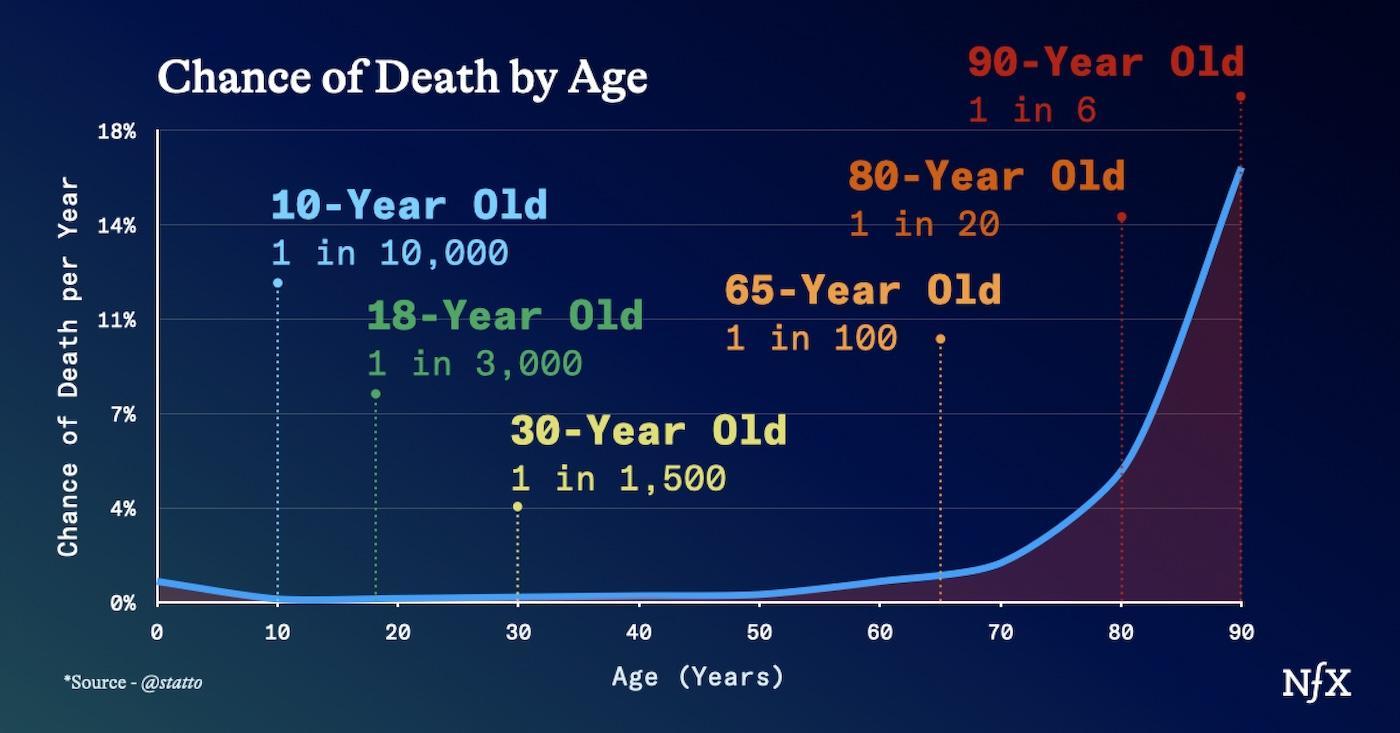

For some species, mortality remains low and constant no matter what age they are. There are actually at least nine species that display “negligible senescence “ – which means their bodies don’t really break down with age.
The only thing that really threatens those animals is external bad luck – like getting eaten by a snake.
Naked mole rats, for example, have a low and constant risk of death throughout life. Their biological risk of dying per year of life looks something like this:
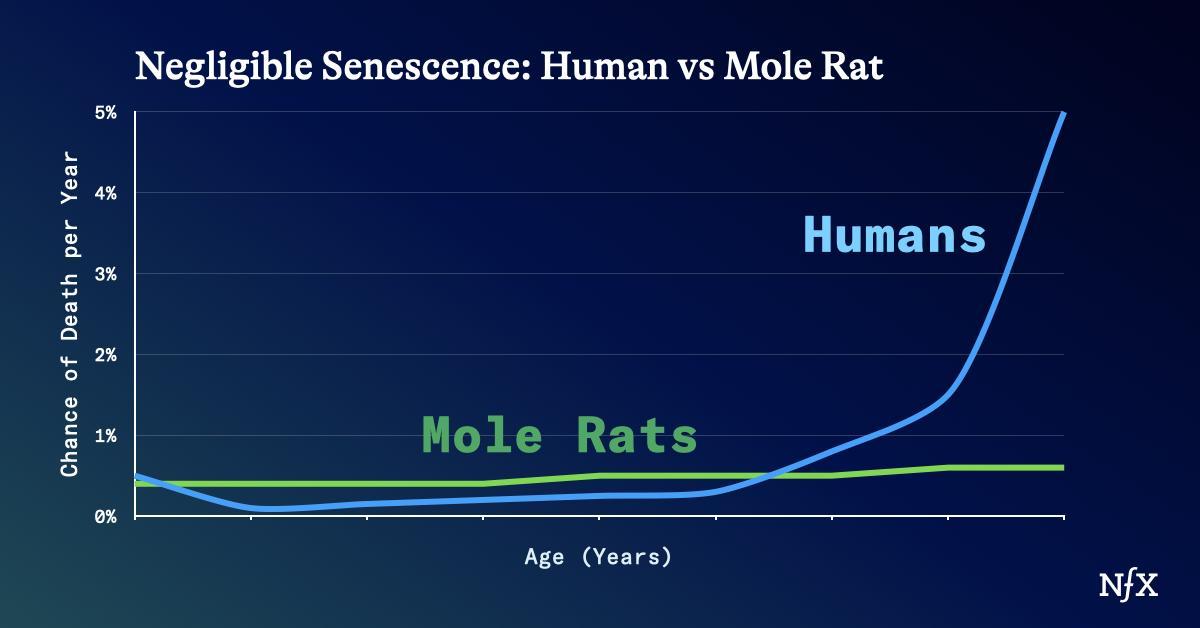

We can get to 160 and beyond by developing technologies that make us more like naked mole rats (hopefully without looking like them). We want to keep our risk of dying constant and low throughout life by renewing ourselves constantly. By keeping the body from breaking down.
This doesn’t mean making small step changes. It means we need hardcore longevity biotech.
“Hardcore Longevity” and the Race to 160
We can’t afford to think small. Time and entropy are working against us. Aging, and the breakdown of the body, is exponential. So for any therapy to see an effect, a small change won’t be enough. You’ll just get steamrolled by nature’s breakdown process.
We need to see big changes on the order of 100x to really roll back (or stop) the clock…we call this “hardcore longevity.”
Hardcore longevity is an approach to creating breakthrough technologies that will get us over that 160 wall. They’re things that feel like magic to you now, the same way a vaccine may have felt like magic to people in the 1900s.
In our view, here are the strongest technologies in hardcore longevity:
1. Replacement
These are technologies that will allow us to fully replace damaged tissues, organs, or even full systems or bodies. Think of this as replacing damaged parts with new “young” parts instead of trying to solve all the many things that break down when we age.
We already have evidence that biology knows how to renew itself:
- Older people can create young babies!
- Wounds heal given the right environments.
- Animals like axolotls can regrow body parts.
Longevity companies are beginning to understand how these renewal systems work and are developing therapies based on them.
My company, Renewal Bio, has developed stem cell-derived embryo models (Stembroids). Stembroids are fundamentally different from human embryos, as they’re created using pluripotent stem cells and bypass natural fertilization. But they hold huge potential to develop patient-specific, young cells and tissues. Think: organ replacements that don’t require donors or immunosuppression, or eggs that could have been derived from an identical twin to help treat infertility.
It’s a hardcore approach – and it has the greatest potential to truly get us to the 160 mark and beyond.
2. Bioengineering
These are the tools we will use to repair ourselves over time. Think of this as a way of reaching into your car and repairing and maintaining specific parts throughout your lifetime.
This category has several sub-themes:
Gene Therapy: Reliable platforms and tools for modifying, manipulating, or repairing genes.
In the long term, gene therapy could help us fix the underlying genetic causes of aging and age-related diseases. But it could also be a form of short-term repair at the blueprint level. It could help restore genes that become broken due to transcription errors that will naturally happen (and increase) as our bodies age. It’s yet another way of renewing yourself.
NFX portfolio company Mammoth Biosciences is an example of a company here. They’ve developed a plethora of novel, smaller CRISPR systems – opening the door to specific, precision gene editing. That leads us to permanent, in-vivo cures to genetic disease.
Reprogramming: converting aged or damaged cells back to a more youthful state. Think of this like being able to restore your car to factory settings. An older car will run like new.
This approach is inspired by the work on induced pluripotent stem cells, where adult cells are reprogrammed to an embryonic-like state. Longevity researchers are exploring how we can apply similar techniques to rejuvenate cells within our bodies, effectively reversing the effects of aging. This could lead to therapies that restore function to aged tissues and organs.
Companies like Altos Labs, Retro Biosciences, and New Limit are all exploring avenues for reprogramming.
Drug Delivery + Programmable Drugs: we know it’s still going to be difficult to deliver therapies to trillions of cells throughout the body. We need better therapies and ways to deliver those therapies to the right cells and tissues.
That’s why we are still going to need hyper-specific drug delivery systems (and programmable drugs) that can reach their targets reliably.
We’re seeing exciting progress like:
- The development of personalized and programmable RNA therapeutics (Our portcos Eleven Therapeutics, La Jolla Labs and Radar Therapeutics are working on this),
- Reprogramming of immune cells to deliver therapeutic proteins (NFX-backed Edity)
- The use of AI to discover novel AAVs and LNP for gene therapy delivery (Dyno, and NFX-backed Mana bio)
3. Cryogenics or Biostasis (aka Plan C)
Plan C consists of techniques that preserve our bodies and minds for such a time in the future that we have made better progress. It’s not our first choice, but it’s a backup plan.
Cryogenics involves freezing the body at very low temperatures to halt biological processes, with the hope of future revival and repair. Biostasis aims to achieve a similar outcome through methods like suspended animation, slowing down the body’s functions to preserve it until advanced medical technologies can be applied.
Most of the energy in the longevity space should be flowing in these three directions, but…
We Aren’t On Track
If you think about the progress on aging that could be happening right now, you should be getting pissed off.
We have solid technologies that could get us over the wall. There are scientifically valid avenues to explore. But we are lacking funding, companies, founders, FDA approval pathways and more…
These bottlenecks encourage people to think too small when we could be thinking big. We shouldn’t be aiming for gradual progress. One of my biggest issues as a longevity investor right now is that I see lack of ambition – too many companies, that, even if successful, won’t move the needle a lot.
We need to be racing to 160 like our lives and the lives of our loved ones depend on it – because they do!
If you’re like us you should be getting annoyed at how slow we are going. We need to be aiming for big jumps, faster, to get over that wall.
We know that with Techbio, and entrepreneurship, we can do it.
Getting over the wall means watching your great grandkids grow up. Feeling healthy and fulfilled for your whole life. We can be the generation that both experiences that, and brings that reality to humanity forever.
Or we could live in a world where people die of aging.
The choice is up to you.
If you’ve made the choice to join us on the race to 160 – come talk to me.
As Founders ourselves, we respect your time. That’s why we built BriefLink, a new software tool that minimizes the upfront time of getting the VC meeting. Simply tell us about your company in 9 easy questions, and you’ll hear from us if it’s a fit.
